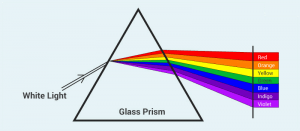The nature of light waves and analysis of white light
The light waves
The light is an external factor that affects the eye causing the sense of vision, The light waves are electromagnetic transverse waves that can travel through free space with velocity 300000 km/sec.
The light waves are formed of crests and troughs, and the speed of light is the distance covered by the light in one second, the light is electromagnetic radiation within a certain portion of the electromagnetic spectrum.
The visible light is one of the components of the electromagnetic spectrum of wavelength ranges between 380 to 700 nanometres, It is between infrared (with longer wavelenths) and the ultraviolet (with shorter wavelengths), infrared and ultraviolet are also called light.
Analysis of white light
Analysis of white light is the splitting of white light into seven colours called the spectrum colours, When the white light falls on a triangular glass prism, it analysis into seven spectrum colours and they have different wavelengths of the light.
The Sun is the main source of light energy on the Earth’s surface, and if you put a compact disc (CD) on a table such that its glistening surface faces the Sunrays (a source of white light), you will observe the formation of seven colours.
The white light consists of a mixture of seven colours which are known as “The spectrum colours”, and these colours are Red – Orange – Yellow – Green – Blue – Indigo – Violet.
Red has the lowest deviation (It is the closest to the prism apex), the lowest frequency, and the longest wavelength, Violet has the highest deviation (it is the closest to the prism base), the highest frequency, and the shortest wavelength.
The energy of the photon of red light is smaller than the energy of the photon of violet light because the energy of the photon is directly proportional to the frequency.
The German scientist Max Plank proved in 1900 that the energy of light waves is composed of energy quanta known as “photons”, The energy of the photon (E) is directly proportional to the frequency of the light wave (F).
The energy of the photon = Plank’s constant Χ Frequency of the photon
Dispersion of White light analysis, Normal prism and thin prism
Light waves properties, Analysis of white light, Spectrum colours & Light intensity
Light refraction effects, Law of light refraction, Mirage & Apparent positions of objects




